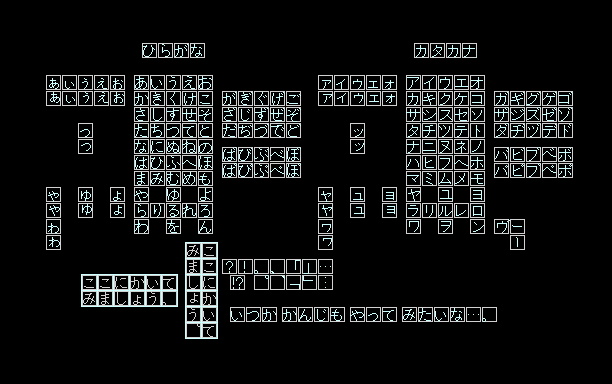Hiragana/Katakana(Japanese Letter) by andy1260

Now we can write japanese on TPT. I hope to make Kanji(Chinese Letter) someday.
letter
japanese
japan
weeabo
anime
roach
m3m3
Comments
-
alice_loona_OT12 14th Oct 2019
 As stated below, P,T,K are unvoiced, or *voiceless* B,D,G. SH here is palatalized, with the tongue closer to the *hard palate* (the hard, flat "Y-place" inside the mouth), producing a "lighter" sound.
As stated below, P,T,K are unvoiced, or *voiceless* B,D,G. SH here is palatalized, with the tongue closer to the *hard palate* (the hard, flat "Y-place" inside the mouth), producing a "lighter" sound. -
alice_loona_OT12 14th Oct 2019
 It is when a syllable's consonant (only plosives like P,T,K -> B,D,G and fricatives like SH -> "J" like French J) gets voiced.
It is when a syllable's consonant (only plosives like P,T,K -> B,D,G and fricatives like SH -> "J" like French J) gets voiced. -
alice_loona_OT12 14th Oct 2019
 (Hiragana is not "hirakana" because of something called *rendaku*, which is VERY frequent in Japanese.)
(Hiragana is not "hirakana" because of something called *rendaku*, which is VERY frequent in Japanese.) -
alice_loona_OT12 14th Oct 2019
 The hiragana and katakana, collectively known as kana, are //syllabaries//.
The hiragana and katakana, collectively known as kana, are //syllabaries//. -
alice_loona_OT12 14th Oct 2019
 Here, the "A-row' is an A-column on the left, keep that in mind for these comments.
Here, the "A-row' is an A-column on the left, keep that in mind for these comments. -
alice_loona_OT12 14th Oct 2019
 Hiragana are the bendy ones [left]. Katakana are the sharp ones [right].
Hiragana are the bendy ones [left]. Katakana are the sharp ones [right]. -
alice_loona_OT12 14th Oct 2019
 Nice. | | | To those learning JPN: This is literal child's play. Kanji is the hardest part for everyone involved-- the students and the teachers.
Nice. | | | To those learning JPN: This is literal child's play. Kanji is the hardest part for everyone involved-- the students and the teachers. -
User-159747 10th Jun 2019
 Should've made hiragana/katakana tables in 2 different saves so you could have written the sounds under the characters.
Should've made hiragana/katakana tables in 2 different saves so you could have written the sounds under the characters. -
KungZacharias 16th Feb 2018
 tHiS iS jUsT tHe BaSiCs
tHiS iS jUsT tHe BaSiCs -
soyO 14th Feb 2018
 I don't know, but it's cool:3
I don't know, but it's cool:3